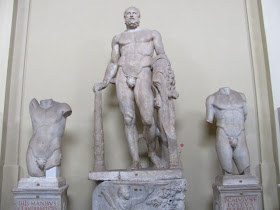The goal for our 3rd day in Rome was the Vatican and St. Peter's Basilica. Since it was across the river we did use the local bus.
 |
| The square in front of St. Peter's Basilica was crowded with people. Some like us, waiting in line to get in, others just wandering around. It was about a 45 minute wait to get in and it was free. |
 |
| The Vatican City is recognized as an independent country with its own police and security force. |
 |
| There are several tours of St. Peter's. We first went underground to visit the tombs of previous Pope's. Then when we exited we had to go around to the front again to go into the cathedral itself. |
 |
| Inside St. Peter's Basilica, the largest cathedral in the world. After having been in so many other cathedral's over the past few days, it really was just another very fancy church. |
 |
| Next it was on to the Vatican itself. We had been told to get there early (before 8am), or wait until about 2pm if we didn't want to wait in line. Well, we didn't and boy, did we have to wait in line. The line went up the street, then around the corner for this distance again before turning the corner again to the entrance. We stood in line almost 3 hours. But we met a lot of interesting people while waiting. |
























No comments:
Post a Comment